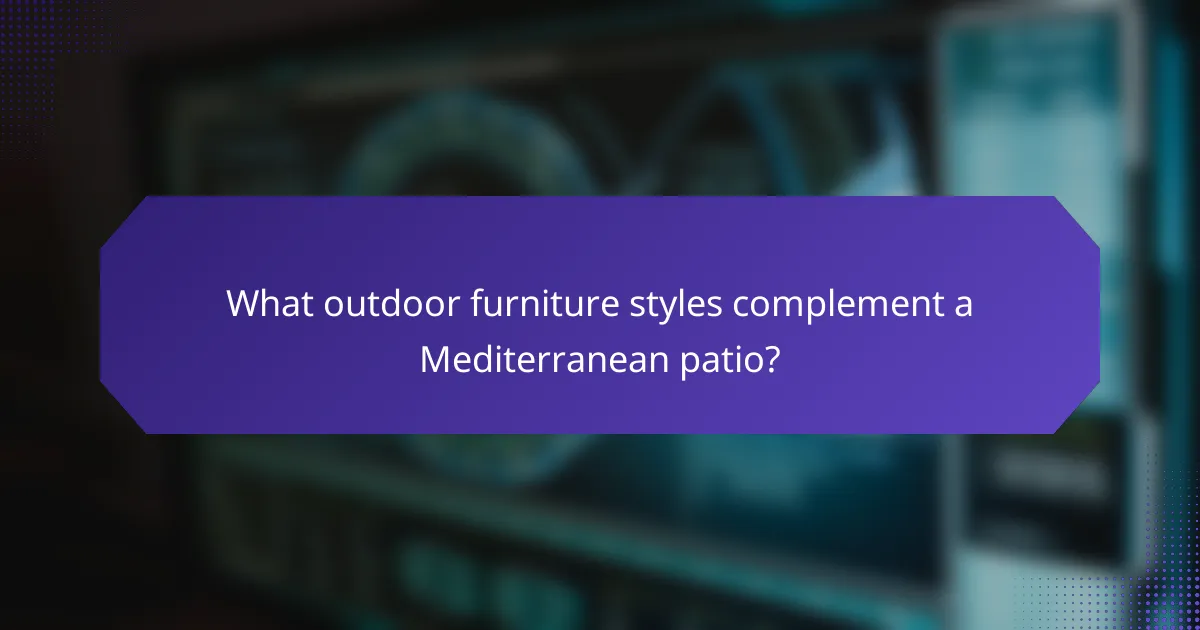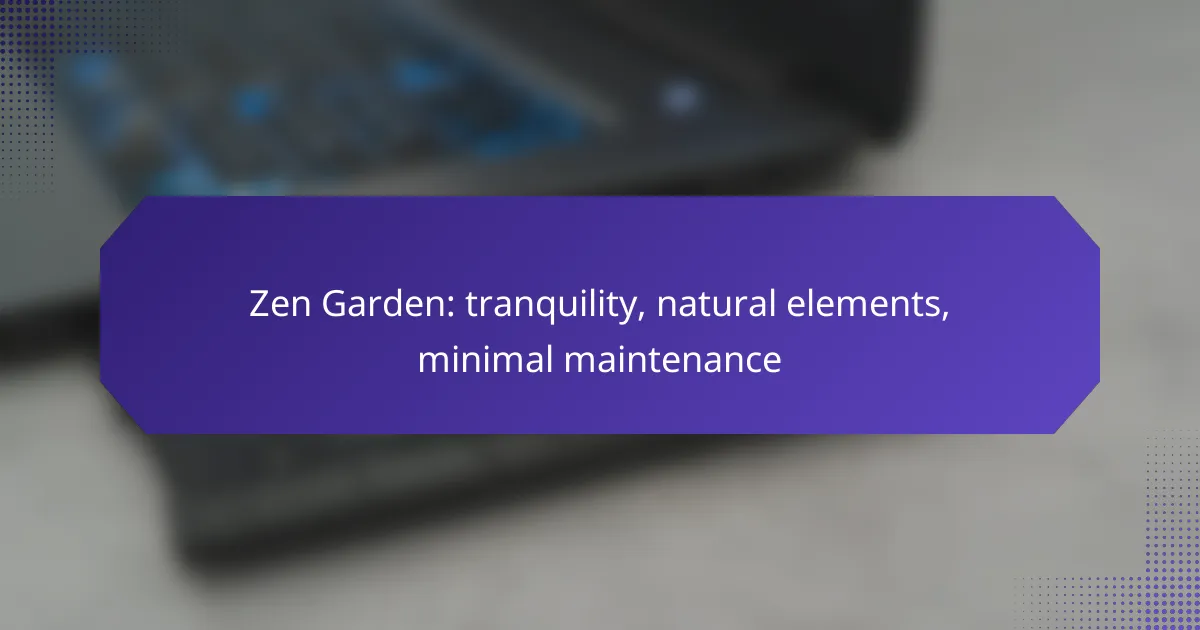Transforming your outdoor space into a Mediterranean patio in Canada allows you to enjoy vibrant aesthetics and a relaxed atmosphere. By incorporating colorful tiles, lush greenery, and comfortable seating, you can create a welcoming environment that captures the essence of Mediterranean living while accommodating the local climate. Choose plants that thrive in cooler temperatures and select durable, slip-resistant tiles to ensure your patio remains beautiful and functional year-round.

How to create a Mediterranean patio in Canada?
Creating a Mediterranean patio in Canada involves blending vibrant aesthetics with practical considerations for the local climate. Focus on colorful tiles, lush plants, and comfortable seating to capture the essence of Mediterranean outdoor living while ensuring durability and comfort in varying weather conditions.
Incorporate vibrant tiles
Vibrant tiles are a hallmark of Mediterranean design, adding color and personality to your patio. Opt for ceramic or porcelain tiles that can withstand Canadian weather, selecting hues like terracotta, cobalt blue, or sunny yellow to evoke a warm atmosphere.
Consider using patterned tiles for a unique look, but ensure they are slip-resistant for safety. A popular choice is to create a mosaic effect, which can be achieved with a mix of different colors and shapes for added visual interest.
Add lush greenery
Lush greenery brings life to your Mediterranean patio, creating a refreshing environment. Choose hardy plants that thrive in Canada’s climate, such as lavender, rosemary, or ornamental grasses, which can withstand colder temperatures.
Incorporate potted plants and vertical gardens to maximize space and add layers of texture. Utilizing planters made from natural materials like terracotta can enhance the Mediterranean feel while providing good drainage for your plants.
Choose comfortable outdoor furniture
Comfortable outdoor furniture is essential for enjoying your Mediterranean patio. Look for weather-resistant materials such as aluminum or teak, which can endure the Canadian climate while providing comfort.
Opt for cushioned seating with removable covers for easy cleaning and maintenance. Consider a mix of lounge chairs, a dining table, and perhaps a hammock or daybed to create inviting spaces for relaxation and social gatherings.
Utilize shade structures
Shade structures are vital for enjoying your patio during hot summer days. Consider installing a pergola or a retractable awning to provide relief from the sun while maintaining an open feel.
Adding climbing plants like wisteria or grapevines can enhance the shade structure, creating a natural canopy that adds to the Mediterranean ambiance. Ensure that any structure is securely anchored to withstand wind and snow, common in many Canadian regions.

What are the best plants for a Mediterranean patio in Canada?
The best plants for a Mediterranean patio in Canada include species that thrive in well-drained soil and can withstand cooler temperatures. Consider options like olive trees, lavender, succulents, and various herbs, as they not only enhance the aesthetic but also adapt well to the Canadian climate.
Olive trees
Olive trees are iconic in Mediterranean gardens and can be grown in Canada, particularly in containers that can be moved indoors during harsh winters. They prefer full sun and well-drained soil, making them ideal for patios. Look for cold-hardy varieties, such as ‘Arbequina’, which can tolerate temperatures down to -10°C.
When planting, ensure the pot has drainage holes and use a mix of potting soil and sand to improve drainage. Regular watering is essential, but avoid overwatering, as olive trees are susceptible to root rot.
Lavender
Lavender is a fragrant herb that thrives in sunny, dry conditions, making it perfect for a Mediterranean patio. In Canada, varieties like ‘Munstead’ and ‘Hidcote’ are popular due to their hardiness and beautiful blooms. They require well-drained soil and should be watered sparingly.
To promote healthy growth, prune lavender plants annually after flowering. This helps maintain their shape and encourages new growth, ensuring vibrant blooms in the following season.
Succulents
Succulents are excellent choices for a Mediterranean patio due to their low maintenance and drought-resistant qualities. Varieties such as Echeveria and Sedum can thrive in containers and add vibrant colors to your outdoor space. They prefer bright sunlight and should be planted in well-draining soil.
When caring for succulents, allow the soil to dry out completely between waterings. Overwatering is a common mistake that can lead to root rot, so it’s best to err on the side of caution.
Herbs like rosemary and thyme
Herbs such as rosemary and thyme are staples in Mediterranean cooking and can easily be grown on a patio in Canada. These herbs thrive in sunny spots and well-drained soil, making them ideal for container gardening. They are also drought-tolerant, requiring minimal watering once established.
For optimal growth, harvest herbs regularly to encourage bushier growth and prevent them from becoming leggy. Both rosemary and thyme can be used fresh or dried in various dishes, adding flavor to your culinary creations.

How to select tiles for a Mediterranean patio?
Selecting tiles for a Mediterranean patio involves choosing vibrant colors and patterns that reflect the region’s aesthetic while ensuring they are suitable for outdoor use. Focus on slip-resistant and durable materials to withstand weather conditions and foot traffic.
Consider color and pattern
When selecting tiles, vibrant colors such as blues, terracotta, and earthy tones are quintessential for a Mediterranean look. Patterns can range from intricate mosaics to simple geometric designs, enhancing the visual appeal of your outdoor space.
Mixing and matching different tile colors and patterns can create a unique and inviting atmosphere. Consider using accent tiles to highlight specific areas, such as around planters or seating arrangements.
Choose slip-resistant materials
For safety, opt for tiles that have a slip-resistant surface, especially in areas prone to moisture. Textured tiles or those with a matte finish can significantly reduce the risk of slipping.
Look for tiles rated with a high coefficient of friction (COF) for outdoor use. This ensures that even when wet, the tiles provide adequate traction, making your patio safer for family and guests.
Evaluate durability for outdoor use
Durability is crucial when selecting tiles for outdoor patios. Choose materials that can withstand temperature fluctuations, UV exposure, and moisture without fading or cracking.
Porcelain and natural stone tiles are popular choices due to their resilience. Ensure that the tiles are rated for outdoor use, as indoor tiles may not hold up well in an outdoor environment.

What outdoor furniture styles complement a Mediterranean patio?
Outdoor furniture that complements a Mediterranean patio typically features durable materials and vibrant designs. Key styles include wrought iron, teak wood, and rattan, each offering unique aesthetics and functionality suited for outdoor living.
Wrought iron furniture
Wrought iron furniture is a classic choice for Mediterranean patios, known for its durability and intricate designs. It can withstand various weather conditions, making it ideal for outdoor use. Look for pieces with ornate patterns that reflect the artistic heritage of Mediterranean culture.
When selecting wrought iron, consider lightweight options for easy rearrangement. Ensure the finish is rust-resistant, especially in coastal areas where salt can accelerate corrosion.
Teak wood options
Teak wood is prized for its natural beauty and resistance to moisture, making it a top choice for Mediterranean outdoor spaces. Its rich, golden hue complements the vibrant tiles often found in these settings. Teak furniture can last for decades with minimal maintenance, making it a practical investment.
To maintain teak, regularly apply a protective oil to enhance its color and prevent drying. Avoid placing teak furniture in direct sunlight for extended periods to prevent fading.
Rattan seating
Rattan seating adds a casual yet stylish touch to Mediterranean patios. Its lightweight nature allows for easy movement and rearrangement, perfect for social gatherings. Rattan is available in both natural and synthetic varieties, with synthetic options offering enhanced durability against the elements.
When choosing rattan furniture, look for UV-resistant materials to prevent fading and cracking. Pair rattan seating with colorful cushions to enhance comfort and aesthetic appeal, creating a vibrant outdoor atmosphere.

What are the costs associated with building a Mediterranean patio?
Building a Mediterranean patio involves various costs, including materials, landscaping, and furnishings. Overall expenses can vary widely based on the size of the patio, the quality of materials chosen, and the complexity of the design.
Tile installation costs
Tile installation costs can range from moderate to high depending on the type of tiles selected. Traditional Mediterranean tiles, often vibrant and patterned, can cost anywhere from $5 to $20 per square foot, excluding installation. Labor costs for professional installation typically add another $5 to $15 per square foot.
Consider the total area of your patio when budgeting for tiles. For example, a 200-square-foot patio could cost between $2,000 and $7,000 for tiles and installation combined. Always factor in additional costs for underlayment and grout.
Planting and landscaping expenses
Planting and landscaping expenses can vary significantly based on the types of plants and features you choose. Mediterranean gardens often include drought-resistant plants, which can be more cost-effective in the long run. Expect to spend anywhere from $500 to $2,500 on plants, soil, and landscaping services.
Incorporating features like stone pathways or decorative pots can increase costs. A well-planned layout can help maximize your budget while creating a lush, inviting atmosphere.
Furniture and decor budget
The budget for furniture and decor can range widely based on style and quality. Basic outdoor furniture sets can start around $300, while high-end options may exceed $3,000. Consider materials that withstand outdoor conditions, such as teak or aluminum.
Additionally, decorative elements like cushions, outdoor rugs, and lighting can enhance the ambiance. A budget of $500 to $1,500 for decor is reasonable to create a comfortable and stylish Mediterranean patio.

How to maintain a Mediterranean patio?
Maintaining a Mediterranean patio involves regular care to preserve its vibrant tiles and lush greenery. Focus on cleaning, plant care, and seasonal adjustments to keep the outdoor space inviting and functional.
Cleaning the Tiles
To maintain the beauty of your Mediterranean patio, regularly clean the tiles to prevent dirt and grime buildup. Use a mixture of warm water and mild detergent for routine cleaning, and avoid harsh chemicals that can damage the tile finish.
For stubborn stains, a paste of baking soda and water can be effective. Apply it directly to the stain, let it sit for a few minutes, then scrub gently with a soft brush.
Caring for Plants
Plants are essential to a Mediterranean patio, so ensure they receive proper care. Water them regularly, especially during dry spells, but avoid overwatering to prevent root rot.
Consider using native Mediterranean plants such as lavender or rosemary, which thrive in similar climates and require less maintenance. Prune them as needed to encourage healthy growth and shape.
Seasonal Adjustments
Seasonal changes can affect your patio’s upkeep. In the spring, focus on planting and refreshing soil, while summer may require more frequent watering and shade management.
As fall approaches, clear away fallen leaves and prepare plants for cooler temperatures. In winter, consider protecting sensitive plants from frost with covers or relocating them indoors if necessary.










